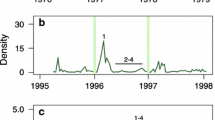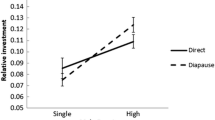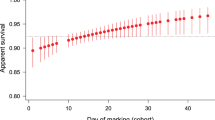Summary
The evolutionarily stable (or ESS) emergence schedule for males of univoltine butterflies is analysed in an environment in which the female emergence schedule fluctuates stochastically between years. The ESS emergence curve, computed using the mutant invadability criterion, is shown to be the one that maximizes mean logarithmic lifetime mating success in the population in which it dominates. If males have accurate information about the female emergence schedule within each year, their emergence curve would evolve to the one predicted by a deterministic game model. The male emergence curve would then shift between years, closely following year to year changes in the female emergence pattern. If, instead, males have uncertainty about the female emergence schedule, the ESS male emergence curve becomes broader than the one predicted by the deterministic game model and will not track the between-year fluctuation of female emergence well. In a special case, we show how the between-year variation of mean emergence date, the variance of emergence date, the sexual difference in mean emergence dates (protandry) and the between-year correlation of mean emergence dates of both sexes should change with the degree of accuracy of information available to males.
Similar content being viewed by others
References
Baughman, J.F., Murphy, D.D. and Ehrlich, P.R. (1988) Emergence patterns in male checkerspot butterflies: testing theory in the field.Theor. Pop. Biol. 33, 102–13.
Bulmer, M. (1983) Models for the evolution of protandry in insects.Theor. Pop. Biol. 23, 314–22.
Fagerstrom, T. and Wikland, C. (1982) Why do males emerge before females? Protandry as a mating strategy in male and female butterflies.Oecologia 52, 164–6.
Haccou, P. and Iwasa, Y. (1994) The optimal mixed strategies in stochastic environments. (in pressTheor. Popul. Biol.)
Iwasa, Y., Odendaal, F.J., Murphy, D.D., Ehrlich, P.R. and Launer, A. (1983) Emergence patterns in male butterflies: a hypothesis and a test.Theor. Pop. Biol. 23, 363–9.
Johnson, N.L. and Kotz, S. (1970)Continuous Univariate Distributions—1. Wiley & Sons, New York.
Levins, R. (1968)Evolution in Changing Environments. Princeton University Press, Princeton, NJ.
Lewontin, R.C. and Cohen, D. (1969) On population growth in a randomly varying environment.Proc. Natl Acad. Sci. USA 62, 1056–60.
Parker, G.A. and Courtney, S.P. (1983) Seasonal incidence: adaptive variations in the timing of life history stagesJ. theor. Biol. 105, 147–55.
Patel, J.K. and Read, C.B. (1982)Handbook of the Normal Distribution. Marcel Dekker, New York
Sasaki, A. and Ellner, E. (1994) The evolutionarily stable strategy in fluctuating environments. (in pressEvolution)
Wiklund, C. and Fagerstrom, T. (1977) Why do males emerge before females? A hypothesis to explain the incidence of protandry in butterflies.Oecologia 31, 153–8.
Wolfram, S. (1991)Mathematica, A System for Doing Mathematics by Computer. Addison-Wesley, Redwood-City, CA.
Yoshimura, J. and Clark, C.W. (1991) Individual adaptations in stochastic environments,Evol. Ecol. 5, 173–92.
Yoshimura, J. and Clark, C.W. (eds) (1993)Adaptations of Stochastic Environments, Lecture Notes in Biomathematics, Vol. 98. Springer-Verlag, New York.
Zonneveld, C. and Metz, J.A.J. (1991) Models on butterfly protandry: virgin females are at risk to die.Theor. Pop. Biol. 40, 308–21.
Author information
Authors and Affiliations
Rights and permissions
About this article
Cite this article
Iwasa, Y., Haccou, P. ESS emergence pattern of male butterflies in stochastic environments. Evol Ecol 8, 503–523 (1994). https://doi.org/10.1007/BF01238255
Issue Date:
DOI: https://doi.org/10.1007/BF01238255




